Switching to gluten-free baking can feel overwhelming at first. With so many alternative flours and binders, it’s hard to know where to start. But the truth is, once your pantry is stocked with the essential gluten-free baking ingredients, you’ll be ready to whip up delicious muffins, cookies, pancakes, and even bread with confidence.
In this guide, you’ll learn exactly what you need — from flours and starches to binders and leaveners — to master gluten-free baking at home.
🌾 1. Gluten-Free Flours
These are your building blocks in gluten-free baking. A well-rounded pantry should include a few different options because no single gluten-free flour behaves exactly like wheat flour.
✅ 1.1 Oat Flour
Is oat flour gluten-free? Yes!
- Mild, slightly sweet flavor
- Best for muffins, cookies, pancakes
- Blend rolled oats to make your own
Recommended Product:
👉 Anthony’s Organic Oat Flour – Buy on Amazon
✅ 1.2 Almond Flour
- Rich, moist, slightly nutty
- Great for cookies, cakes, brownies
- High in protein and healthy fats
Affiliate Product:
👉 Blue Diamond Almond Flour – Buy on Amazon
✅ 1.3 Coconut Flour
- Very absorbent (use sparingly!)
- High fiber, low carb
- Ideal for keto and paleo baking
✅ 1.4 Sorghum, Millet, or Teff Flour
- Whole-grain options with more structure
- Excellent in bread and muffins when blended
🍚 2. Starches & Lighteners
To mimic the texture of wheat flour, you need to combine heavier flours (like almond) with starches or light flours.
✅ 2.1 Tapioca Starch
- Adds chewiness and light texture
- Great for binding
Affiliate Product:
👉 Bob’s Red Mill Tapioca Flour – Buy on Amazon
✅ 2.2 Potato Starch
- Not to be confused with potato flour
- Gives softness to baked goods
✅ 2.3 Arrowroot Powder
- Neutral taste, helps with crisping
- Good for cookies and crusts
🧬 3. Binders (To Replace Gluten)
Gluten provides elasticity and structure. Without it, you need binders to hold everything together.
✅ 3.1 Xanthan Gum
- Most commonly used binder
- Use ½ to 1 tsp per cup of flour
Affiliate Product:
👉 NOW Foods Xanthan Gum – Buy on Amazon
Low Competition Keyword: xanthan gum gluten-free baking
✅ 3.2 Psyllium Husk Powder
- Great for gluten-free bread
- Adds chewiness and elasticity
✅ 3.3 Ground Flaxseed or Chia Seeds
- Mix with water to create a “flax egg”
- Adds fiber and moisture
🧂 4. Leavening Agents
Gluten-free doughs need extra help rising because they’re often denser.
- Baking Soda
- Baking Powder (Gluten-Free Labeled!)
- Apple Cider Vinegar – Often used with baking soda for a better rise
Suggested Post: How to Make Gluten-Free Bread That Actually Rises (soon)
🥛 5. Liquid & Moisture Boosters
Gluten-free batters dry out faster — keep them moist with:
- Eggs (or egg replacements)
- Applesauce
- Greek Yogurt
- Nut Butters
- Non-dairy milk (almond, oat, coconut)
🧁 6. Pre-Made Flour Blends (For Convenience)
When you need a shortcut, a gluten-free flour blend does the trick. Make sure it contains xanthan gum or add your own if it doesn’t.
Top Picks:
- 👉 Bob’s Red Mill Gluten Free 1-to-1 Baking Flour
- 👉 King Arthur Measure for Measure Gluten-Free Flour
🍪 Example Pantry Setup (Beginner-Friendly)
| Ingredient | Why You Need It |
|---|---|
| Oat Flour | Mild, versatile base |
| Almond Flour | Adds richness |
| Tapioca Starch | Improves texture |
| Xanthan Gum | Key binder |
| Baking Powder | Lifting agent |
| Applesauce | Adds moisture |
| Eggs | Helps with rise and structure |
Suggested Internal Link: Top 5 Easy Gluten-Free Recipes for Beginners (soon)
❓ FAQ: Essential Gluten-Free Baking Ingredients
Q1: Do I need to use multiple flours when baking gluten-free?
Yes — combining flours and starches gives you the best texture and flavor balance.
Q2: Is xanthan gum always necessary?
Not always, but it’s essential in bread or cookies for structure unless you’re using a pre-mixed blend with binders.
Q3: What’s the best all-purpose gluten-free flour?
Try Bob’s Red Mill 1-to-1 or King Arthur’s Measure for Measure — both are excellent.
Q4: Can I make my own flour blend?
Yes! A good DIY base: 40% whole grain (e.g., oat), 60% starch (e.g., tapioca + potato).
Q5: How should I store gluten-free flours?
In airtight containers. Some, like almond or oat flour, keep best in the fridge or freezer.
🧁 Final Thoughts
Stocking your pantry with the right gluten-free baking ingredients is the first step toward delicious, fail-proof recipes. Once you understand the role of each flour, binder, and starch, you’ll be ready to bake cookies, breads, and cakes that everyone will love — whether they eat gluten or not.
👉 Ready to start? Grab your essential ingredients, and check out our Gluten-Free Banana Muffins (soon) or Simple Oat Flour Cookies (soon) for your first bake!

Leave a Reply